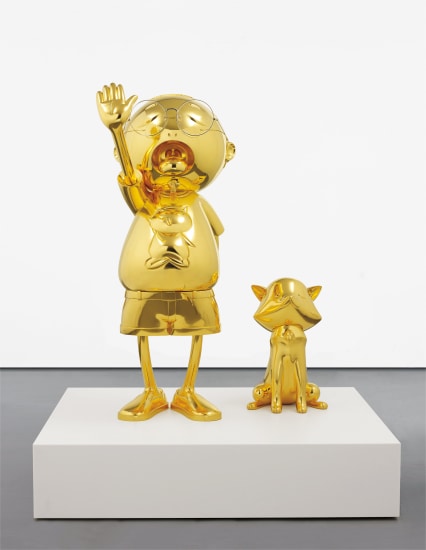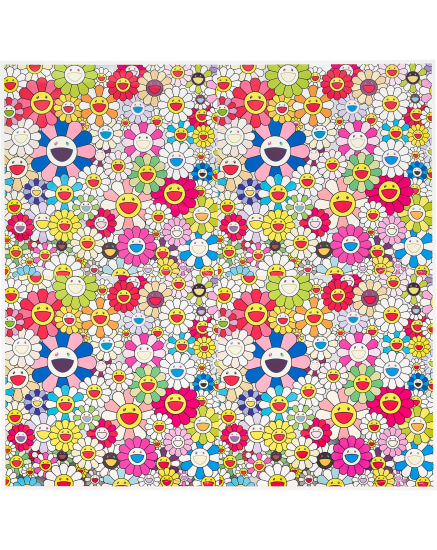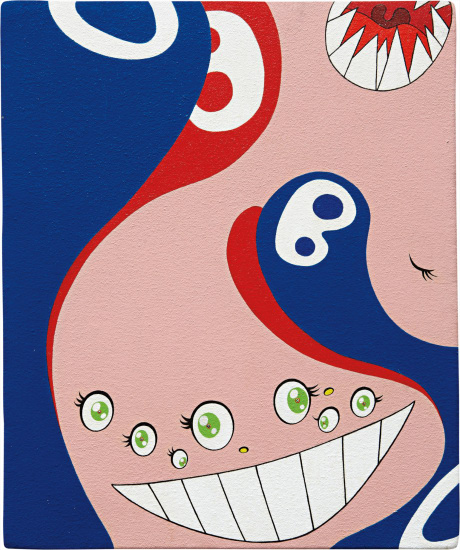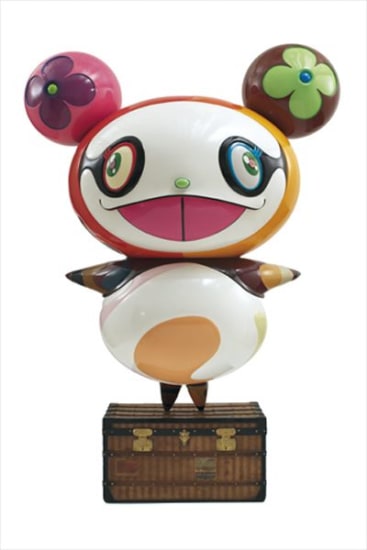62 Takashi Murakami Army of Mushrooms 2002 acrylic on canvas laid on plywood 71 1/8 x 70 7/8 in. (180.5 x 180 cm) Signed and dated "TAKASHI 02" on the reverse. Stamped five times by the artist's studio "Kaikai Kiki, New York" and annotated with the names of the studio artists.
Provenance Blum & Poe, Los Angeles Exhibited London, Dairy Art Centre, Island, October 11 – December 8, 2013 Manchester, Manchester Art Gallery, Facing East, February 4 -April 11, 2010 Catalogue Essay "In Japan I am famous in certain special circles—mainly as someone who is trying to break down and enlighten the conventions of Japanese art." Takashi Murakami 2013 There is no artist quite like Murakami: the writer, director, painter, curator, sculptor, designer, animator and businessman has successfully turned his superflat aesthetic into a globally celebrated and recognized brand. After gaining a doctorate in Nihonga, a distinctly Japanese style of painting that is made in accordance with traditional Japanese conventions, techniques and materials, Murakami, an avid follower of manga, became interested in depicting postwar Japanese culture through incredibly refined pop iconography. Traumatized and infantilized, the collective psyche of postwar Japan grasped onto kawaii imagery in an obsessive draw to all things cute. Viewing kawaii as both attractive and repulsive, Murakami incorporated its language into his aesthetic as a way to explore what it says about Japanese contemporary culture and history. Murakami took a commercial approach to his aesthetic through pop sensibilities as a way to emphasize the shallowness of consumer culture. In this sense Murakami’s entire oeuvre explores the ways in which mass-produced entertainment and consumerism function within the tradition of fine art and essentially blurs the traditional lines between art, commerce, and pop culture. In the case of the present lot, it is not only the mushroom motif that conjoins historical periods, but also the style in which they are rendered. In Army of Mushrooms, the titular fungi are drawn with bold outlines, grounded squarely in two dimensions. They belong to a longstanding dimensional tradition within Japanese aesthetics, as articulated by Murakami in his theory of the Superflat. They refer not only to a particular moment in the early twenty first century, but also to an enduring national tradition. Nonetheless, it is the influence of anime stylistics that is felt most acutely. A kawaii sensibility suffuses the piece; in their clean lines and light colors, the anthropomorphic fungi draw heavily upon the kitsch aesthetic. Meanwhile, the composition of the piece recalls a neatly arranged set: a panoply of variegated characters. The connotations are of collectability: a notion which is itself central to the fan-culture surrounding both anime and manga. Given his interest in intersections and points of coalescence, the mushroom is an ideal motif for Murakami. The spore-laden fungus has a long history in Japanese culture, and is heavy with associative weight. Although part of the iconography of anime, the history of the mushroom in Japanese visual culture predates these contemporary forms. Peter Daszak and Sara E. Howard observe that “the mushroom ‘[appears] repeatedly in traditional Japanese art’ (Peter Daszak and Sara E. Howard, ‘Fungal Foray’, Eco Health 9, 2012, p.103), citing Ito Jakuchu’s eighteenth Century screens and Yumeji Takehisa‘s early twentieth century textiles by way of example. It is a subject, or symbol, in which the contemporary and the historical collide, and which traces a lineage through ‘high’ and ‘low’ art. Alongside these quaint associations sit rather more mature concerns. The largest mushroom’s eyes droop as though in a daze, intimating the fungus’ link to hallucinogenic power. Indeed the palette and design of the piece, its vivid pools of color, playfully hint at the mushroom’s place in the tradition of psychedelia. Murakami himself suggests a further dimension to the work; “for me [mushrooms] seem both erotic and cute while evoking – especially for the Western imagination – the fantastic world of fairy tale” (Takashi Murakami as quoted in “Takashi Murakami”, Initial Access). Returning to the largest mushroom, one notices the batting
62 Takashi Murakami Army of Mushrooms 2002 acrylic on canvas laid on plywood 71 1/8 x 70 7/8 in. (180.5 x 180 cm) Signed and dated "TAKASHI 02" on the reverse. Stamped five times by the artist's studio "Kaikai Kiki, New York" and annotated with the names of the studio artists.
Provenance Blum & Poe, Los Angeles Exhibited London, Dairy Art Centre, Island, October 11 – December 8, 2013 Manchester, Manchester Art Gallery, Facing East, February 4 -April 11, 2010 Catalogue Essay "In Japan I am famous in certain special circles—mainly as someone who is trying to break down and enlighten the conventions of Japanese art." Takashi Murakami 2013 There is no artist quite like Murakami: the writer, director, painter, curator, sculptor, designer, animator and businessman has successfully turned his superflat aesthetic into a globally celebrated and recognized brand. After gaining a doctorate in Nihonga, a distinctly Japanese style of painting that is made in accordance with traditional Japanese conventions, techniques and materials, Murakami, an avid follower of manga, became interested in depicting postwar Japanese culture through incredibly refined pop iconography. Traumatized and infantilized, the collective psyche of postwar Japan grasped onto kawaii imagery in an obsessive draw to all things cute. Viewing kawaii as both attractive and repulsive, Murakami incorporated its language into his aesthetic as a way to explore what it says about Japanese contemporary culture and history. Murakami took a commercial approach to his aesthetic through pop sensibilities as a way to emphasize the shallowness of consumer culture. In this sense Murakami’s entire oeuvre explores the ways in which mass-produced entertainment and consumerism function within the tradition of fine art and essentially blurs the traditional lines between art, commerce, and pop culture. In the case of the present lot, it is not only the mushroom motif that conjoins historical periods, but also the style in which they are rendered. In Army of Mushrooms, the titular fungi are drawn with bold outlines, grounded squarely in two dimensions. They belong to a longstanding dimensional tradition within Japanese aesthetics, as articulated by Murakami in his theory of the Superflat. They refer not only to a particular moment in the early twenty first century, but also to an enduring national tradition. Nonetheless, it is the influence of anime stylistics that is felt most acutely. A kawaii sensibility suffuses the piece; in their clean lines and light colors, the anthropomorphic fungi draw heavily upon the kitsch aesthetic. Meanwhile, the composition of the piece recalls a neatly arranged set: a panoply of variegated characters. The connotations are of collectability: a notion which is itself central to the fan-culture surrounding both anime and manga. Given his interest in intersections and points of coalescence, the mushroom is an ideal motif for Murakami. The spore-laden fungus has a long history in Japanese culture, and is heavy with associative weight. Although part of the iconography of anime, the history of the mushroom in Japanese visual culture predates these contemporary forms. Peter Daszak and Sara E. Howard observe that “the mushroom ‘[appears] repeatedly in traditional Japanese art’ (Peter Daszak and Sara E. Howard, ‘Fungal Foray’, Eco Health 9, 2012, p.103), citing Ito Jakuchu’s eighteenth Century screens and Yumeji Takehisa‘s early twentieth century textiles by way of example. It is a subject, or symbol, in which the contemporary and the historical collide, and which traces a lineage through ‘high’ and ‘low’ art. Alongside these quaint associations sit rather more mature concerns. The largest mushroom’s eyes droop as though in a daze, intimating the fungus’ link to hallucinogenic power. Indeed the palette and design of the piece, its vivid pools of color, playfully hint at the mushroom’s place in the tradition of psychedelia. Murakami himself suggests a further dimension to the work; “for me [mushrooms] seem both erotic and cute while evoking – especially for the Western imagination – the fantastic world of fairy tale” (Takashi Murakami as quoted in “Takashi Murakami”, Initial Access). Returning to the largest mushroom, one notices the batting











Try LotSearch and its premium features for 7 days - without any costs!
Be notified automatically about new items in upcoming auctions.
Create an alert